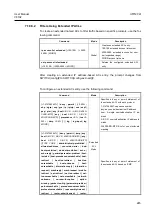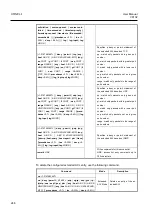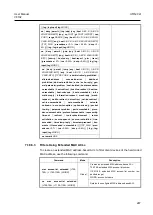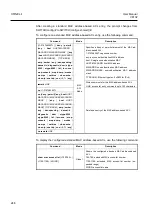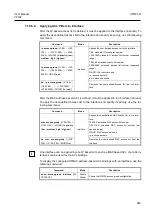
UMN:CLI
User Manual
V8102
234
7.17
Packet Dump
Failures in network can occurr by certain symptom. Each symptom can be traced to one
or more problems by using specific troubleshooting tools. The V8102 switch provides the
debug command to dump packet. Use debug commands only for problem isolation. Do
not use it to monitor normal network operation. The debug commands produce a large
amount of processor overhead.
The V8102 also provides debug command for Layer 3 routing protocols (BGP, OSPF,
RIP). If you want to debug about them, refer to the each configuration chapter.
7.17.1
Packet Dump by Protocol
You can see packets about BOOTPS, DHCP, ARP and ICMP using the following com-
mand.
Command
Mode
Description
debug packet
{
interface
INTERFACE
|
port
PORTS
}
protocol
{
bootps
|
dhcp
|
arp
|
icmp
}
{
src-ip A.B.C.D
|
dest-ip
A.B.C.D
}
Enable
Shows packet dump by protocol.
debug packet
{
interface
INTERFACE
|
port
PORTS
}
host
{
src-ip
A.B.C.D
|
dest-ip
A.B.C.D
}
{
src-port
<1-65535> |
dest-port
<1-65535>}
Shows host packet dump.
debug packet
{
interface
INTERFACE
|
port
PORTS
}
multicast
{
src-ip
A.B.C.D
|
dest-ip
A.B.C.D
}
Shows multicast packet dump.
7.17.2
Packet Dump with Option
You can verify packets with TCP dump options using the following command.
Command
Mode
Description
debug packet
OPTION
Enable
Shows packet dump using options.
Tab.7.4 shows the options for packet dump.
Option
Description
-a
Change Network & Broadcast address to name.
-d
Change the complied packet-matching code to readable letters and close it
-e
Output link-level header of each line
-f
Output outer internet address as symbol
-l
Buffer output data in line. This is useful when other application tries to receive data
from tcpdump.
-n
Do not translate all address (e.g. port, host address)
-N
When output host name, do not print domain.
-O
Do not run packet-matching code optimizer. This option is used to find bug in optimiz-
er


























